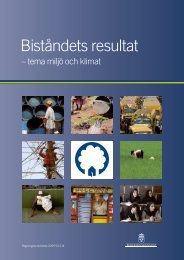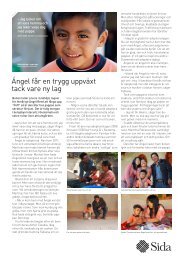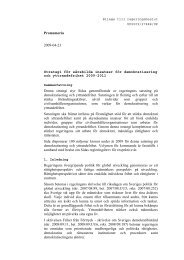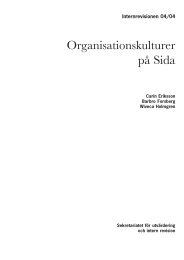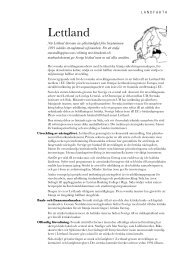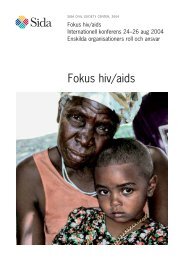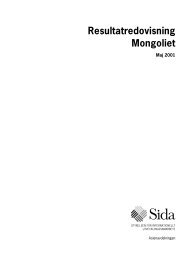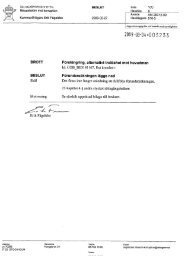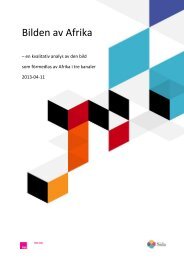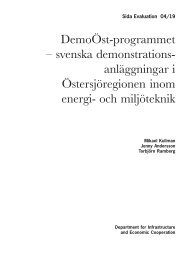Mid-Term Review of the AGIR Programme - Sida
Mid-Term Review of the AGIR Programme - Sida
Mid-Term Review of the AGIR Programme - Sida
Create successful ePaper yourself
Turn your PDF publications into a flip-book with our unique Google optimized e-Paper software.
2 F I N D I N G S<br />
support <strong>the</strong> capacity streng<strong>the</strong>ning <strong>of</strong> partner CSOs who, through this streng<strong>the</strong>ning,<br />
enhance <strong>the</strong>ir ability to work with civil society and citizens, is a viable approach. The<br />
interaction between <strong>the</strong> different spheres <strong>of</strong> influence (donor –intermediary-CSObeneficiary)<br />
is logical, and, by which <strong>the</strong> programme can determine <strong>the</strong> pathways <strong>of</strong><br />
change allowing for <strong>the</strong> identification and documentation <strong>of</strong> associated outcomes.<br />
There is <strong>the</strong> question associated with <strong>the</strong> need for <strong>the</strong> <strong>AGIR</strong> programme to pay increased<br />
attention to its overall management <strong>of</strong> implementation activities through <strong>the</strong><br />
lens <strong>of</strong> a programme and not as grouping <strong>of</strong> sub-programmes but this does not decrease<br />
<strong>the</strong> appropriateness <strong>of</strong> <strong>the</strong> <strong>the</strong>ory <strong>of</strong> change upon which it operates.<br />
The participation <strong>of</strong> CSO partners across <strong>the</strong> different sub-programmes continues to<br />
increase in response to <strong>the</strong> work <strong>of</strong> <strong>the</strong> <strong>AGIR</strong> intermediary organisations. As discussed<br />
earlier, <strong>the</strong>re are now 43 active established CSO partnerships, 32 surpassing <strong>the</strong><br />
39 partnerships that were expected by <strong>the</strong> end <strong>of</strong> 2014. This growth is important, but<br />
a few overall critical issues came out <strong>of</strong> <strong>the</strong> evaluation team’s meetings with intermediary<br />
organisations. One concern relates to <strong>the</strong> critical balance between quantity and<br />
quality. By taking in many partners, are <strong>the</strong> qualitative outcomes <strong>of</strong> <strong>AGIR</strong> in danger<br />
<strong>of</strong> being compromised? What happens if <strong>AGIR</strong> capacity building and support becomes<br />
too mechanical and structured? If this is <strong>the</strong> case, is <strong>the</strong>re a real danger <strong>of</strong><br />
hampering <strong>the</strong> process <strong>of</strong> creating a vibrant civil society that requires a more dynamic<br />
approach with <strong>the</strong> support process oriented and tailored in accordance with <strong>the</strong> specific<br />
level <strong>of</strong> capacity and local circumstances surrounding an individual organisation?<br />
At <strong>the</strong> beginning <strong>of</strong> <strong>the</strong> programme, each <strong>of</strong> <strong>the</strong> intermediaries started with a few<br />
well-established central-level partners who have a broad scope and proven relevant<br />
track records with respect to <strong>AGIR</strong> <strong>the</strong>mes. In many cases, <strong>the</strong> intermediary organisations<br />
had previous collaborative relationships with <strong>the</strong>se partners. The focus on national<br />
organisations can be regarded as a good approach if <strong>the</strong> intention is to ensure<br />
that <strong>the</strong>re is a vertical integration <strong>of</strong> resources and outcomes.<br />
The concept <strong>of</strong> ‘trickle down support’ however, where capacities at <strong>the</strong> central level<br />
are instrumental to streng<strong>the</strong>ning organisations at <strong>the</strong> local level, and that, in turn, this<br />
will produce ‘trickle up effects’ – where results from grass roots activism and evidence<br />
ga<strong>the</strong>ring informs policies and national advocacy at <strong>the</strong> central level – can be<br />
flawed. As seen in <strong>the</strong> programme, <strong>the</strong>re can be a narrowing <strong>of</strong> <strong>the</strong> support process<br />
that sees funds moving down and/or outwards to local areas (and sub-partners) being<br />
constrained so that local organisations do not have <strong>the</strong> resources to undertake <strong>the</strong><br />
work that is central to <strong>the</strong>ir activism. Combined with a challenging governance envi-<br />
32 This number does not include some partner organisations whose contracts have been suspended<br />
due to non-adherence to internal governance criteria, <strong>the</strong>se measures relate to i.e. MONASO, MEPT<br />
and MISA.<br />
67




